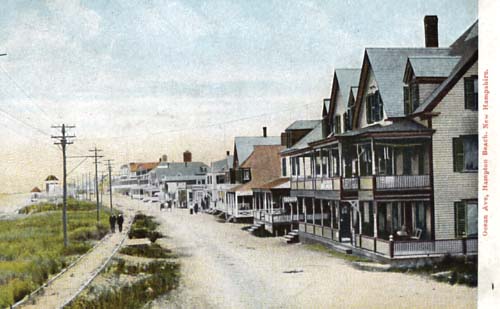By Frances Paul, Second Grade Teacher
Hampton Centre School
Hampton Union, Ca. 1970s
[The following article is courtesy of the Hampton Union and Seacoast Online.]

Postcard shows Ocean Avenue, later Ocean Boulevard at Hampton Beach.
(ca. 1906 Photo Postcard from the Tuck Museum collection,
John M. Holman, Museum Curator, 1970-83.)
In the past, Hampton Beach served in providing part of the food for the early settlers. From the ocean and shore, they took fish, clams, lobsters. They caught a1l kinds of game birds from the marshes. After a storm, seaweed was gathered up and used for fertilizer on the fields. One large area of land to the river was used as pasture for the cattle, horses and oxen.
It was over one hundred years before someone thought of using the beach for pleasure. In 1819 the first public house (where visitors could pay to stay) was built.
After the towns forming, a part of the first Hampton land grant were cutoff; it was recorded that the strip of land adjoining the ocean and known as the beach was to be left for the use and benefit of the public.
One reason the beach area was so slow to develop was because of the lack of good roads to the beach area. The only buildings along the shore were old fishing shacks, where fishermen cleaned their fish and kept their boats.
Finally a road to the south beach was opened and people began to discover the charm and beauty of the beach. Motels were built and soon filled with people. Summer cottages were soon going up all along the shore.
The opening of the electric railway from Exeter to Hampton Beach in 1897, gave many thousands easy access to the beach resort. For 29 years, open and closed electric trolleys ran from Exeter and Amesbury to Hampton and finally to Hampton Beach. This electric car system was known as the Exeter, Hampton and Amesbury Street Railway Company.
One of the newer exhibits in the Tuck Memorial Museum in Hampton, is the “Trolley Era Of Hampton 1897 — 1926”. There are many relics and artifacts depicting the era of the electric car days.
Now from the Hampton River Bridge to the North Hampton line, there is a continuous settlement at the beach. Hampton Beach is one of the cleanest and most beautiful beaches along the Atlantic shore.